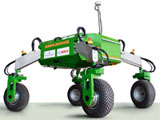Agricultural and Biological Systems Engineering, Department of

Department of Agricultural and Biological Systems Engineering: Faculty Publications
ORCID IDs
Bery 0009-0006-8516-8583
Brown-Brandl 0000-0002-0874-8035
Rohrer 0000-0002-8252-9308
Sharma 0000-0003-1996-673X
Document Type
Article
Date of this Version
12-2023
Abstract
Shoulder sores predominantly arise in breeding sows and often result in untimely culling. Reported prevalence rates vary significantly, spanning between 5% and 50% depending upon the type of crate flooring inside a farm, the animal’s body condition, or an existing injury that causes lameness. These lesions represent not only a welfare concern but also have an economic impact due to the labor needed for treatment and medication. The objective of this study was to evaluate the use of computer vision techniques in detecting and determining the size of shoulder lesions. A Microsoft Kinect V2 camera captured the top-down depth and RGB images of sows in farrowing crates. The RGB images were collected at a resolution of 1,920 × 1,080. To ensure the best view of the lesions, images were selected with sows lying on their right and left sides with all legs extended. A total of 824 RGB images from 70 sows with lesions at various stages of development were identified and annotated. Three deep learning-based object detection models, YOLOv5, YOLOv8, and Faster-RCNN, pre-trained with the COCO and ImageNet datasets, were implemented to localize the lesion area. YOLOv5 was the best predictor as it was able to detect lesions with an mAP@0.5 of 0.92. To estimate the lesion area, lesion pixel segmentation was carried out on the localized region using traditional image processing techniques like Otsu’s binarization and adaptive thresholding alongside DL-based segmentation models based on U-Net architecture. In conclusion, this study demonstrates the potential of computer vision techniques in effectively detecting and assessing the size of shoulder lesions in breeding sows, providing a promising avenue for improving sow welfare and reducing economic losses.
Included in
Bioresource and Agricultural Engineering Commons, Environmental Engineering Commons, Other Civil and Environmental Engineering Commons


Comments
Open access
License: CC BY 4.0